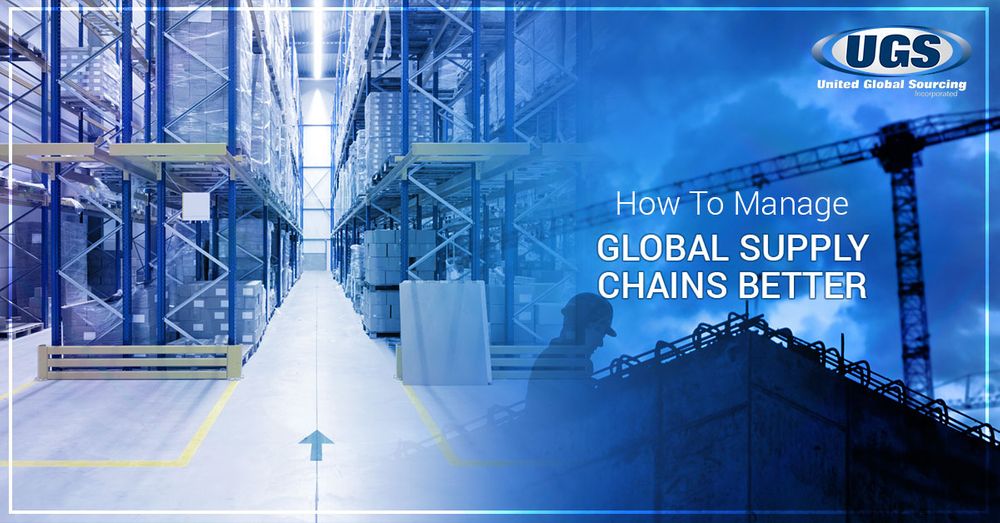The global market is ever expanding. So is the length and complexity of global supply chains. The effort to meet the needs of the market are putting more stress on supply chains and their managers to perform consistently and efficiently. With so much pressure, the temptation to cut corners is ever increasing. Global supply chain management, however, must hold steadfast and do the right thing. Even though global sourcing predated the internet, as did manufacturing, transporting, and distributing, the industry is still in an ever-evolving state. That’s why it’s imperative, as a supply chain manager, to always be searching for ways to improve or enhance supply chain effectiveness and efficiency. Not only do you want to keep the end-customer satisfied, but you also want to find ways to increase profits.

How To Manage Global Supply Chains Better
Establish a Global Communication System
As supply chain manager, it’s imperative to know what everyone is buying in each region. For example, procurement is an area of opportunity. If you have an established communication system, you can better identify, develop, evaluate and commercialize new sources of supply for materials. This can give you a performance advantage, cost advantage, or a security of supply advantage. With any one of these advantages, you can better serve the end-customer, and get a leg up on your competition in the region or around the globe.
Execution Speed
When you consider expanding into new markets, regions, or areas, it’s imperative that your execution in doing so is quick and effective. The ultimate goal, especially if you’re expanding globally to multiple continents, is to meet the customers’ demands. To best execute on this expansion, you have to understand that the process to establish a supply chain can be different between countries. For example, manufacturing establishment and processing is different in China than it is in Brazil. You must understand those differences to execute quickly in regards to your expansion.
Essentially, you’ll be building a new supply chain that demands attention to the finest details. You want to be able to increase execution speed while still maintaining a high level of quality.
Create Supply Reliability
As supply chains continue to expand globally, the complexity of each chain increases. In regards to supply chains and supplies, you must create more reliable sourcing. One way to do this is to digitize physical data so the decision making process is streamlined. A global enterprise resource planning (ERP) system can be extremely powerful in this instance. Also, blockchain technology is quickly taking the supply chain industry by storm, offering a more secure, transparent ledger database for transaction of goods, products, and currencies. Nonetheless, ERP allows for the staff of any one supply chain to see data for said chain and make supply decisions and moves that best suits the overall goal without much debate.
Establish Universal Metrics
As a supply chain manager, it’s important you establish a set of metrics that performance can be measured against. Now, these metrics need to be directly tied to supply chain goals, so the overall perspective of said performance is not skewed. When a set of metrics is established, the entire supply chain can work in unison to achieve those metrics. This creates a more homogenous effort toward consistent high-performance.
Global Supply Chain Risks
It can be daunting to consider all the complexities of supply chains globally, and it’s imperative you also know what some of the major risks are so you can better prepare for them. The goal is to ultimately prevent fraud, waste, and irresponsible actions throughout the entire chain. Here are some risks to keep in mind when better operating supply chains:
- Know Your Suppliers - Gather information externally and internally. Explore the connections your suppliers have with other managers, governments, and entities in the industry. Use this information to mitigate risk when it comes to fraud, waste, or otherwise.
- Map Product Volume Flow - Use product volume flow software to identify potential supply chain risks through unfriendly or volatile regions. Can you change the flow of product away from these areas to decrease risk? If not, how else can you reduce risk while product is in these specific regions?
- Address Anomalies - Collect data to vet transactional data. Review transactions of accuracy, existence, authorisation, and approval. Furthermore, check supplier response times and production duration against other similar suppliers in the industry. Finally, check invoices for rates charged for items, confirming contractual obligations. All of this will help reduce your risk.
- Leverage Information - Data is useless unless you act upon it. The same goes with knowledge; it’s not power until it's leveraged. The same goes with your supply chain information. Use it to establish a supply chain database with metrics you can use for audits on spending, geographical location, and transaction history. To most, the data would look convoluted, but to an experience supply chain manager, the data is where you mitigate risk.
The Global Supply Chain Management Experts
United Global Sourcing is here to help you with your supply chain needs. Whether you need a connection with a manufacturer or a complete supply chain management solution, we can help. Our services extend beyond the connect and vanish routine. We establish a 24-hour communication cycle so you are always informed, and we work to mitigate or eliminate risk within supply chains. When you choose UGS, you get top-tier quality and superb communication.
Ready to discuss your global supply chain needs? Contact UGS today!

